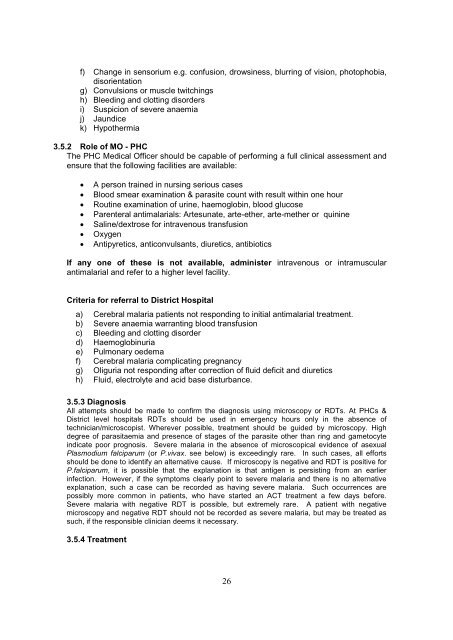Training Module for Medical Officer - NVBDCP
Training Module for Medical Officer - NVBDCP
Training Module for Medical Officer - NVBDCP
Create successful ePaper yourself
Turn your PDF publications into a flip-book with our unique Google optimized e-Paper software.
f) Change in sensorium e.g. confusion, drowsiness, blurring of vision, photophobia,disorientationg) Convulsions or muscle twitchingsh) Bleeding and clotting disordersi) Suspicion of severe anaemiaj) Jaundicek) Hypothermia3.5.2 Role of MO - PHCThe PHC <strong>Medical</strong> <strong>Officer</strong> should be capable of per<strong>for</strong>ming a full clinical assessment andensure that the following facilities are available:A person trained in nursing serious casesBlood smear examination & parasite count with result within one hourRoutine examination of urine, haemoglobin, blood glucoseParenteral antimalarials: Artesunate, arte-ether, arte-mether or quinineSaline/dextrose <strong>for</strong> intravenous transfusionOxygenAntipyretics, anticonvulsants, diuretics, antibioticsIf any one of these is not available, administer intravenous or intramuscularantimalarial and refer to a higher level facility.Criteria <strong>for</strong> referral to District Hospitala) Cerebral malaria patients not responding to initial antimalarial treatment.b) Severe anaemia warranting blood transfusionc) Bleeding and clotting disorderd) Haemoglobinuriae) Pulmonary oedemaf) Cerebral malaria complicating pregnancyg) Oliguria not responding after correction of fluid deficit and diureticsh) Fluid, electrolyte and acid base disturbance.3.5.3 DiagnosisAll attempts should be made to confirm the diagnosis using microscopy or RDTs. At PHCs &District level hospitals RDTs should be used in emergency hours only in the absence oftechnician/microscopist. Wherever possible, treatment should be guided by microscopy. Highdegree of parasitaemia and presence of stages of the parasite other than ring and gametocyteindicate poor prognosis. Severe malaria in the absence of microscopical evidence of asexualPlasmodium falciparum (or P.vivax. see below) is exceedingly rare. In such cases, all ef<strong>for</strong>tsshould be done to identify an alternative cause. If microscopy is negative and RDT is positive <strong>for</strong>P.falciparum, it is possible that the explanation is that antigen is persisting from an earlierinfection. However, if the symptoms clearly point to severe malaria and there is no alternativeexplanation, such a case can be recorded as having severe malaria. Such occurrences arepossibly more common in patients, who have started an ACT treatment a few days be<strong>for</strong>e.Severe malaria with negative RDT is possible, but extremely rare. A patient with negativemicroscopy and negative RDT should not be recorded as severe malaria, but may be treated assuch, if the responsible clinician deems it necessary.3.5.4 Treatment26
















